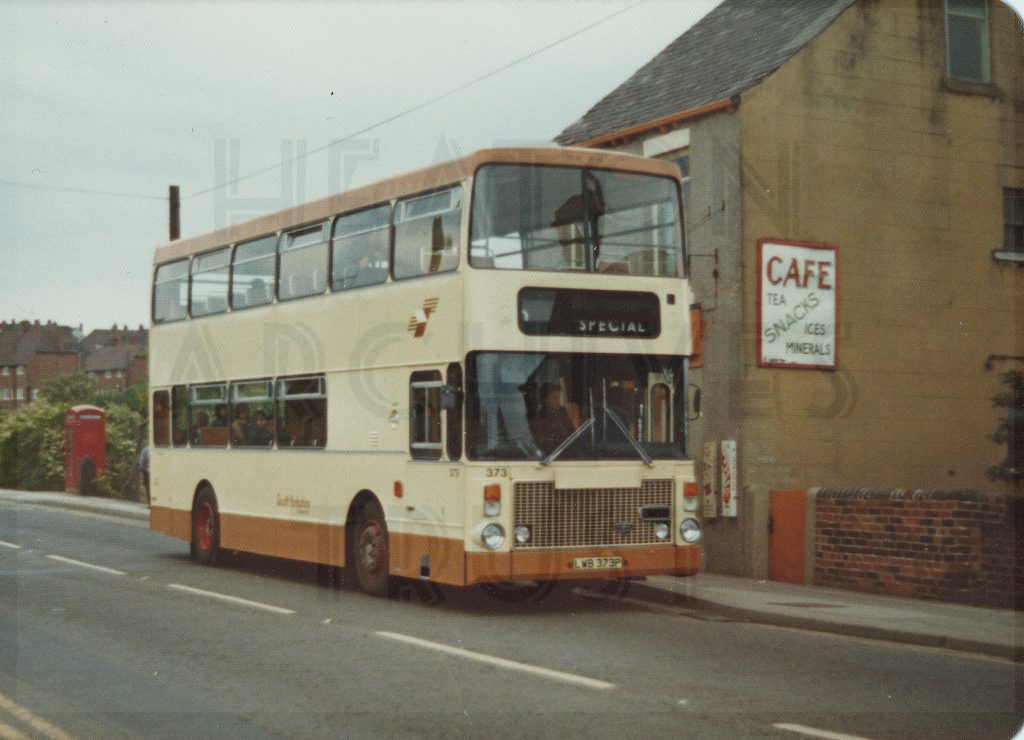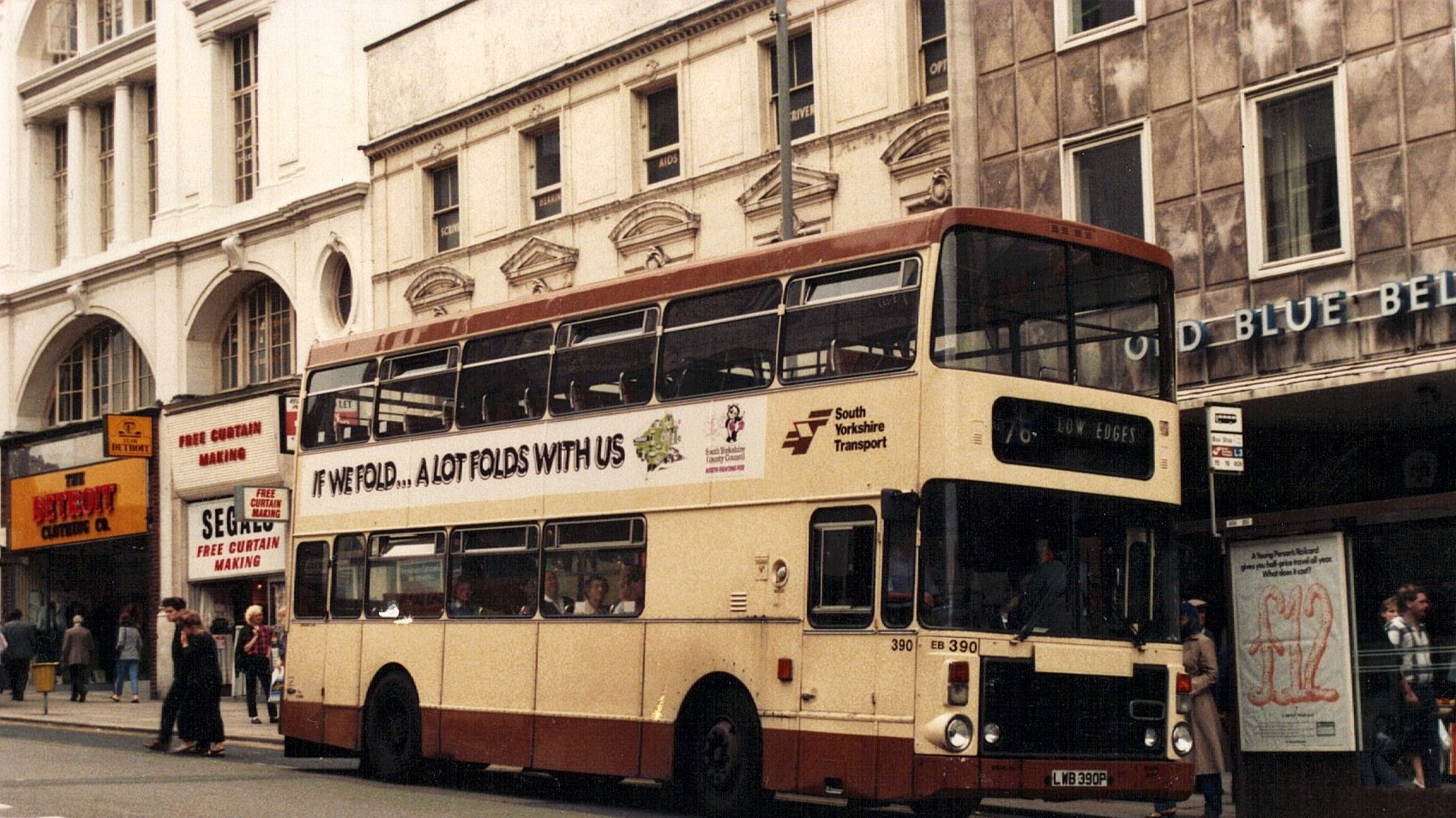The South Yorkshire PTE Volvo Ailsa

About the Buses.
The buses were Fleet Numbers 369 to 430. (LWB369-410P, NAK411-429R, SHL930S)
These unusual buses were delivered new to the South Yorkshire PTE in 1976/77, where they operated in and around the South Yorkshire area for approximately 10 years until being withdrawn from service in 1986.
This unusual combination came about due to supply difficulties with the SYPTE’s preferred product at the time, the Alexander bodied Leyland Fleetline. Leyland could not deliver the chassis at the required time, so the Volvo Ailsa was was chosen. Similarly Alexander, who was the normal body builder for the Volvo chassis at the time, could not supply in the time scale the SYPTE wanted, so Vanhool McArdle was chosen to build the bodywork.
The prototype bus, LWB369P was built in Belgium by Vanhool and the production run was completed by Vanhool McArdle in Dublin. The total build for this chassis/body combination was 64. 62 for the South Yorkshire PTE and 2 for the Scottish Independent A1 Service(Hunter), Ardrossan.
There is an article in the Sheffield Star at the time the buses were delivered new, with the headline ‘The £25,ooo Super Bus’, which in todays’ money is just a shade under £200,000. The first examples started to arrive in Sheffield in April of 1976, and they caused quite a stir. Compared to the other buses around at the time, there was nothing quite like them. The design was way ahead of its time – the wrap around front windscreens was a design that was not to become mainstream for around another 15 years or so. Quite a few locals described them as ‘looking like a spaceship’, as they were so unusual!
Mechanically, the buses were not what had become the norm – they had a front mounted engine, whereas all other new buses at the time were rear engined. The Volvo Ailsa had been developed by Ailsa Trucks, in response to the Scottish Bus Groups general dissatisfaction with the reliability of the rear engined models. The Ailsa had been bought in fairly large numbers in Scotland, but in England it was not a common sight.
The engine was a Turbocharged 6.7 litre Volvo TD70E, producing 204bhp. The gearbox a 5 speed SCG(Self Changing Gears) unit with fully automatic control, mated to a Hamworthy drop centre rear axle, with hub reduction.
When new, the automatic control system on the gearbox gave problems, with the various gear changes it would do lurching the vehicle, throwing the passengers about. There were also problems reported with the braking system, which lead to many of the batch being taken out of service until the problems were resolved.
Teething problems over, the batch settled down to give good service. If you kept that 6.7 litre engine revving well, they would be lively performers, with a top speed considerably higher than the rear engined equivalent. Achieving over 60mph was not uncommon, although they did get a reputation for being rather noisy.
Noise from the engine was no more than the rear engined equivalent, the gearbox would be rather tuneful, but not unpleasant, but the noise from the alternator drive and the drone, grind and howl from the rear axle, whilst great for an enthusiast, can’t have been appreciated very much by the every day passenger.
It is the toothed alternator drive belt that gives these buses their characteristic ‘whistle’ or ‘scream’. The hub reduction gears wore quite quickly, which would cause a loud howl on the overrun and contribute to a constant drone with the power on. The rear axles got incredibly noisy in service, but rarely failed. You could certainly hear an Ailsa coming before you saw it!
Because of their extraordinary sound effects unusual performance and appearance, I have heard them referred to by a number of nic-names over the years. ‘Flat Backs’, ‘Flying Volvos’, ‘Whistling McArdles’, ‘Whistlers’, ‘Screambags’, ‘Screamybuses’, to name a few!
The screaming alternator belts were engineered out from all new Volvo Ailsa’s delivered from mid 1977 onwards, and the Hamworthy rear axle was changed to a quiet running Volvo unit from 1980 onwards, but by that time the model had become the Mk3 version.
After the delivery of the 62 examples in 1976/77 no more were purchased by the SYPTE. The later Mk3 examples were trialed in the form of Glasgow and Derby examples, but lead to no more orders of the type. The SYPTE standardised on the Dennis Dominator from 1981 onwards.
The SYPTE did retro fit one example with the quiet running Volvo axle. This wouldn’t have been straight forward as the Volvo axle was the ‘straight through’ type with no drop centre gears. No more were so treated, most likely due to the decision to phase them out, as there was serious issues with body frame corrosion, along with other problems.
All had been withdrawn from service in South Yorkshire by the end of 1986, but due to deregulation and the high demand for second hand buses, many found new owners. Some did go for scrap direct from the SYPTE, but 25 examples saw further use with Eastern Scottish in Edinburgh, 10 in London, running from Potters Bar, and 10 for Hampshire Bus, initially running in the Southampton area. A handful of these went on for further use with independent operators, with the last ones coming out of use as late as 1997. Due to the Vanhool body’s reputation for corrosion, the remaining examples were in pretty poor condition when they finally came out of use.
Of the original build of 64 of this chassis/body combination, as far as we are aware there are 3 surviving examples. Of the SYPTE vehicles, we have 2 – 377(LWB377P) and 388(LWB388P). One of the A1 Service buses survives, PSJ825R, and is now based at the GVVT, Glasgow, and is in a roadworthy condition. This was based in Sheffield from 1996 until 2011, used extensively, with much work being carried out by the owners of 388.
377 has now been returned to roadworthy condition, with 388 nearing the end of a heavy restoration, which has been ongoing for over 20 years. For more information, please see the individual vehicle sections of this site. I’ll keep adding to it when time permits.
Thanks. Gareth.
